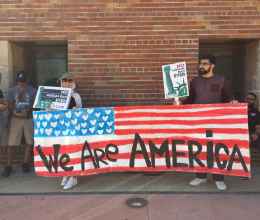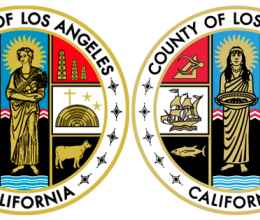 by Peter Eliasberg, ACLU/SC managing attorney and Manheim Family Attorney for First Amendment Rights
by Peter Eliasberg, ACLU/SC managing attorney and Manheim Family Attorney for First Amendment Rights
Court To Examine Whether Transfer of Land With Cross In Mojave Desert National Preserve Remedies Establishment Clause Violation
Salazar v. Buono originated as an Establishment Clause challenge to the presence of a Latin cross on federally-owned land in the Mojave National Preserve in California. During the course of the proceedings, Congress passed a law providing for the transfer of the land on which the cross was located to the Veterans of Foreign Wars (VFW). After prevailing on the Establishment Clause claim, former National Park Service employee Frank Buono successfully challenged the transfer as a sham designed to circumvent the court's judgment in his favor. At issue in the proceedings before the Supreme Court is whether the transfer fully remedies the already adjudicated constitutional violation. The government is also asserting that Mr. Buono lacked standing to bring the Establishment Clause case in the first instance.
Background
A cross was first erected on the site in 1934, but has been torn down and replaced several times since. The current cross, which is about six feet tall, sits on the top of a prominent rock outcropping next to one of the principal roads through the preserve. A plaque announcing that the cross is intended as a memorial for veterans of all wars was placed at the site in 1934, but it has long ago disappeared and not been replaced. In the late 1990s a man asked the National Park Service for permission to erect a stupa ''' a Buddhist memorial ''' at the site. The Park Service refused the request.
Mr. Buono is a retired employee of the National Park Service, a veteran and an observant Catholic. Although he has a Latin cross in his own home, he objects to the presence of a sectarian religious symbol on government property and the favoritism the government has shown by allowing a private party to erect the cross while refusing to allow others to erect other symbols, including other religious symbols in the area.
Court Proceedings
In 2001, Mr. Buono filed a civil action in federal district court alleging the cross violated the Establishment Clause and seeking a permanent injunction. On cross-motions for summary judgment, the district court ruled in Mr. Buono's favor and granted a permanent injunction barring defendants from permitting the display of the cross. During the pendency of the district court proceedings, Congress designated the cross a national memorial commemorating United States participation in World War I and the veterans of that war. It is one of approximately 50 national memorials in the United States, which include Mount Rushmore and the Vietnam Memorial.
The government appealed the district court's judgment. During the pendency of the appeal, Congress enacted a land transfer provision: the National Park Service would transfer approximately one acre of land on which the cross sat to a local chapter of the VFW; in exchange, local resident Henry Sandoz (who had erected the cross) would transfer approximately five acres of land he owned elsewhere in the preserve to the Park Service. In a unanimous opinion by Judge Alex Kozinski, the Ninth Circuit held that Mr. Buono had standing to challenge the cross and that the cross violated the Establishment Clause. The court rejected the government's assertion that the transfer statute mooted the case, noting that the transfer had not yet occurred and might take up to two years to accomplish. The government did not file a petition for certiorari.
Approximately five months after the Ninth Circuit's judgment, Mr. Buono filed a motion in district court to enforce the judgment, arguing that the transfer was inconsistent with the permanent injunction the court had entered. The district court granted the motion and enjoined the transfer. A three-judge panel of the Ninth Circuit unanimously affirmed the district court. At that point, the government filed a petition for certiorari, which the Supreme Court has granted.
Mr. Buono has made several arguments in support of the decision:
First, the 2002 judgment of the district court, as affirmed by the Ninth Circuit in 2004, is a final judgment. By not filing a petition for certiorari from that judgment, the government is precluded from raising ''' five years later ''' all issues encompassed in the judgment, including Mr. Buono's standing to bring the case.
Second, even if the Court concludes that the standing question is properly before it, Mr. Buono had standing to bring this case. He visits the preserve regularly and must either accept the presence of a government-endorsed religious display, which offends him, or undergo burdens to avoid that contact. The Supreme Court has explicitly or implicitly recognized that kind of injury as sufficient for standing purposes in numerous cases.
Third, the lower courts were correct in concluding that the land transfer was not a valid remedy to the already-adjudicated Establishment Clause violation. The government's basic argument is that reasonable people will associate the message conveyed by the cross with the owner of the land on which it sits. Thus, if the government no longer owns the land, it will no longer be seen as endorsing the preeminent symbol of Christianity. That argument ignores the cross' continuing designation as a national memorial and its location in the midst of a national preserve.
Fourth, if the government had wanted to transfer the land, it could have made it available to the highest bidder. By transferring the land to someone who was committed to maintaining the cross at its present location, the government reinforced its endorsement of the religious symbol while, at the same time, denying other religious faiths the opportunity to erect their own, comparable religious displays in the preserve. As the Ninth Circuit found, that sort of religious favoritism compounded the Establishment Clause violation, rather than resolving it.

